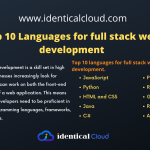7 Top Back-End Languages for Web Development in 2023
7 Top Back-End Languages for Web Development in 2023
In the world of web development, choosing the right back-end language is crucial for building robust, scalable, and efficient web applications. With technology evolving rapidly, it’s essential to stay updated on the top back-end languages that will dominate the web development landscape in 2023. In this blog post, we will explore the seven most prominent back-end languages that will empower developers to create cutting-edge web solutions.
JavaScript (Node.js):
JavaScript has become a powerhouse in the web development realm, not just for front-end but also for back-end development. With the rise of Node.js, JavaScript has expanded its reach to server-side programming, enabling developers to build highly scalable and event-driven applications. Node.js boasts a vast ecosystem of libraries and frameworks, making it a top choice for web developers in 2023.
Python:
Known for its simplicity and readability, Python has gained immense popularity among developers. With frameworks like Django and Flask, Python offers an elegant and efficient way to build web applications. Its extensive collection of libraries, ease of use, and focus on code readability make it a favorite for web development projects.
Java:
Java has long been a reliable choice for enterprise-level back-end development. Its robustness, scalability, and vast ecosystem of frameworks, such as Spring and Hibernate, make it an excellent option for building large-scale web applications. Java’s object-oriented approach and platform independence continue to make it a prominent language in the web development landscape.
Ruby:
Ruby, paired with the Ruby on Rails framework, has gained popularity for its developer-friendly nature and rapid development capabilities. Ruby on Rails follows the “Convention over Configuration” principle, providing developers with a streamlined workflow and reducing the time required to build web applications. It remains a strong contender for back-end development projects in 2023.
PHP:
PHP has been a dominant back-end language for web development for many years. With frameworks like Laravel and Symfony, PHP enables developers to create dynamic and feature-rich web applications. Its wide adoption, extensive documentation, and strong community support make it a reliable choice for building a wide range of web solutions.
Go:
Go, also known as Golang, has gained traction in recent years due to its simplicity, performance, and built-in support for concurrency. Its strong focus on simplicity and efficiency makes it an excellent choice for developing high-performance web services and microservices. Go’s popularity is expected to continue growing in 2023.
C# (ASP.NET):
C# is widely used for enterprise-level back-end development, especially with the ASP.NET framework. With a strong ecosystem, excellent tooling, and seamless integration with other Microsoft technologies, C# enables developers to build robust and scalable web applications. Its popularity among enterprise developers is expected to persist in 2023.
As the web development landscape evolves, it is essential to stay informed about the top back-end languages for 2023. JavaScript (Node.js), Python, Java, Ruby, PHP, Go, and C# (ASP.NET) are the seven key languages that will shape the web development industry. By choosing the right back-end language, developers can create powerful, scalable, and efficient web applications that meet the evolving demands of users and businesses in the coming year.








